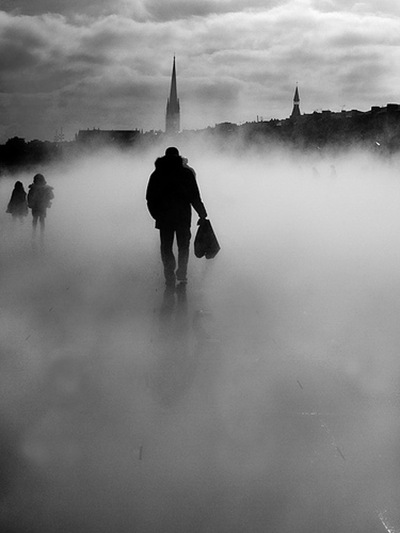 For some reason most of my published books and longer works are walking quests. By that I mean that an individual (often accompanied by a nonhuman companion) sets out on foot to cross a lot of real estate toward some objective. In the course of his travels he usually undergoes death and resurrection (symbolic or literal), and part of his journey takes place on water (replaced by the resurrected Goodyear airship in Elegy Beach).
For some reason most of my published books and longer works are walking quests. By that I mean that an individual (often accompanied by a nonhuman companion) sets out on foot to cross a lot of real estate toward some objective. In the course of his travels he usually undergoes death and resurrection (symbolic or literal), and part of his journey takes place on water (replaced by the resurrected Goodyear airship in Elegy Beach).
This holds true for Ariel, The Architect of Sleep, Elegy Beach, The Gnole, the forthcoming Mortality Bridge and Avalon Burning, my novellas “Prodigy” and “Like Pavlov’s Dogs” — in other words, every longer work I’ve published. (But it isn’t true for longer works I haven’t published. Hmm. Maybe I just learned something important here.)
In these works the landscape is usually stripped bare — not of vegetation or wildlife (though sometimes that’s true too), but of civilization — and most of the rules of society have either been broken or made irrelevant. In this my work has a fascination with what have been called Temporary Autonomous Zones, places where normal law, infrastructure, and hierarchy have been suspended. Except in my case they tend not to be temporary.
Interestingly (well, to me, anyhow), this is true for me in the real world as well. Burning Man and the Northern & Southern California Renaissance Faires of 15 to 20 years ago have held great significance in my life.
I sometimes go to great lengths to ensure that my characters must walk to their goal. Driving, bicycling, rollerblading, waving magic wands, or saying giddyup to your centaur buddy pal are just out. I think my reason for this is in line with my view of Grail quests in general: ya gotta earn yer friggin Grail, pal. You don’t drive to it, you don’t win it in a goddamn lottery. You could, I suppose, but it wouldn’t mean a damn thing to you if you did. I believe (with conviction that sometimes surprises me) that Grails take their careful measure out of your heart. That the price you pay to attain your Grail is always at least the value of the Grail itself. I believe that this is the entire point of grails in general. They are not supposed to be a bargain. He who buys a bargain Grail buys tin.
Another reason I love Walking Stories is because they are a literal (and hopefully literary) embodiment of the adage that “it’s not about the destination, it’s about the journey.” To me, what the destination itself eventually means is shaped by the journey.
The nonhuman companion in these things seems to function (at least partly) as an idealization of some human component — love in Ariel, friendship in The Architect of Sleep, duty in Elegy Beach, loyalty in Avalon Burning. Maybe they’re variations on Jiminy Cricket, I dunno. I am aware that one of the great pleasures and powers of fantasy fiction is that metaphors can be manifest. (I’m also aware that when these metaphors are obvious it’s a Bad Thing, which is why I loathe every word ever perpetrated by C.S. Lewis.)
Do we pick our themes and obsessions? Man, I don’t know. I don’t really even know where they come from. What I do know is that Stephen King’s The Stand and The Long Walk, The Odyssey, The Inferno, The Lord of the Rings, Don Quixote, Gene Wolfe’s Latro books (Soldier of the Mist, Soldier of Arete, Soldier of Sidon) and his Book of the New Sun tetralogy, Heinlein’s Glory Road, all of Cormac McCarthy’s Western novels and The Road, Delany’s Neveryon books, and I’m sure many more struck resounding chords in me when I read them — whether I encountered them in elementary school or last month.